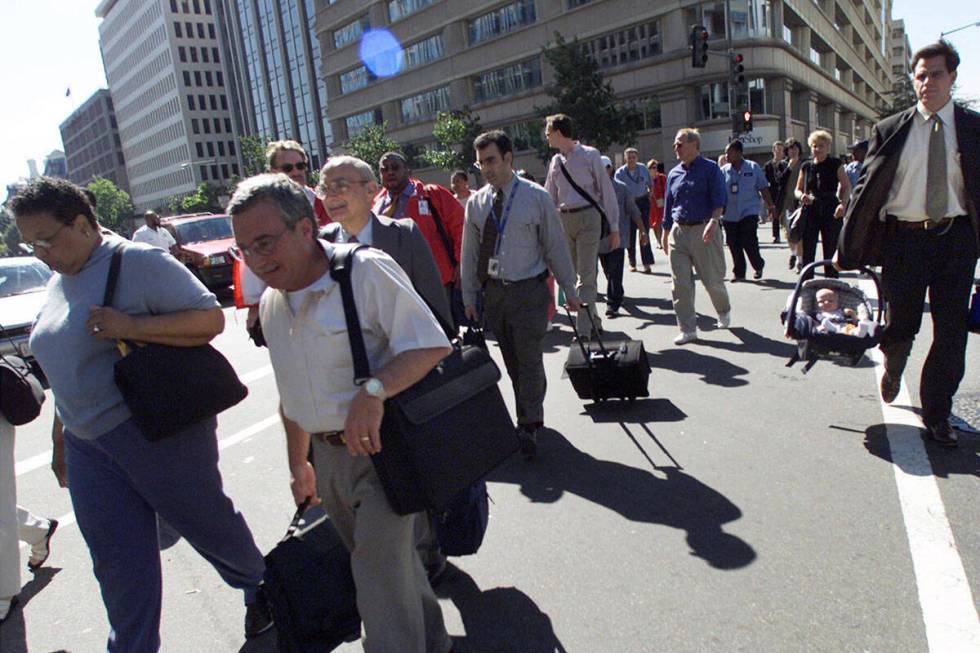RJ reporter describes ‘shattering’ 9/11 experience near White House

WASHINGTON — Legendary journalist Helen Thomas frantically announced that the West Wing of the White House was being evacuated. It was the first thing I remember about Sept. 11, 2001.
We were in our office at 1701 Pennsylvania Ave., directly across from the White House. She was shouting at me.
I was a White House correspondent for a Texas newspaper at the time, and Thomas was a regular in the briefing room as a Hearst Newspapers columnist.
The urgency and tone of her voice shocked me. I was at my desk eating a Danish pastry from Au Bon Pain, watching television in amazement as a commercial jet airliner struck a World Trade Center tower in New York.
Unbelievably, another aircraft hit a second tower.
What followed in the next hours and days completely changed life in Washington, and the world.
As I ran across Pennsylvania Avenue with my notebook, I was stopped by the muzzle of a black semiautomatic rifle and a uniformed officer who ordered me to return to 17th Street.
I showed my White House press pass, but he was having none of that.
He shouted, and I quickly moved to the street.
Related: ‘Mass pandemonium:’ Nevadans remember day of terror in Washington
An acquaintance from San Antonio, Steve Ruhlen, the vice president’s deputy assistant for legislative affairs, suddenly appeared on the street. We shared an anxious conversation. He told me Dick Cheney was in “the bunker,” which clearly signaled a situation of hostility.
President George W. Bush, I knew, was in Florida.
Ruhlen had been in the Eisenhower Executive Office Building, next to the White House, for a meeting. After watching events in New York unfold, he was told by a supervisor to get out of the building. Then alarms sounded.
“That’s when they came in and got Cheney,” Ruhlen recalled.
He walked out to 17th Street.
“I saw you. And that’s when I looked up and saw the smoke coming up from the Pentagon,” he remembered.
Looking directly down 17th Street, and across the Potomac River, thick smoke was rising. In the other direction, I watched colleagues running through the Northwest Gate at the White House to Lafayette Square.
A police cordon began to evacuate a 1-mile area around the White House.
Huddled with other reporters covering the White House, at the top of Lafayette Square, we watched the sky with nervous anticipation.
Our cellphones did not work, except for one belonging to Don Gonyea with NPR. He said another plane likely was headed to Washington.
Speculation swirled. Was it headed for the Capitol or the White House?
If a commercial aircraft hit the White House, I remember thinking, we would be incinerated.
Later we learned that Flight 93 was forced down when a group of courageous passengers charged the terrorists who controlled the cockpit. The aircraft went down in Shanksville, Pennsylvania, killing 40 people onboard.
An editor in Texas demanded I go to the Pentagon to cover the mayhem there. Traffic made that unthinkable. And the cordon going up around the White House made the order seem unreasonable.
I disobeyed.
Inside the cordon, close to the White House, I had access to whatever else would come. Who knew if the attack was over, and whether the presidential residence first occupied by George Washington would be targeted — today or later.
It was a symbolic target, and no one knew what was coming.
Federal law enforcement in trucks and Humvees rounded up people on the street to escort them out of the sealed area. I smoked cigarettes at the time. I couldn’t stand on the street to fire up. I was forced to the loading dock in the alley to avoid detection.
The news staff in the Washington office worked to piece together what we could. It was incomplete and confusing.
Outside, it was eerie. Silent.
Reagan National Airport closed. The sky was empty, except for military jets that would scream over the city during frequent flyovers.
After filing words to be combined with other stories to my newspaper 1,600 miles away, I decided to leave, knowing well that I would not be able to return to the office soon.
But I remember feeling numb. The experience was shattering.
Washington was shut down. Not able to access the office, I worked from home and without the technology available today.
About a week later, with the country still reeling and the losses mounting in New York and Washington, a benefit concert was held in the Big Apple to acknowledge and recognize the first responders who risked lives to save lives at the World Trade Center.
Lying on the couch, I watched as musicians and bands who influenced me during the rebellious ’60s and ’70s took the stage. I became emotional.
The Who, one of my favorite bands growing up, sang, “Won’t Get Fooled Again.” It was a youthful anthem that, as a teenager, I sang along with full-throated volume.
But on this night, Pete Townsend and Roger Daltrey brought new meaning to the song. It seemed a direct response, and a threat, to the attackers.
Months later, I delivered a lecture at Flagler College in St. Augustine, Florida. I spoke to journalism students about my recollections of 9/11, and how it had changed my life and perceptions.
During the lecture I told them about The Who, and how they doubled down on the volume and emotion.
I knew then that the world I grew up in had completely changed.
The song’s meaning had changed. I had, too.
Contact Gary Martin at gmartin@reviewjournal.com. Follow @garymartindc on Twitter.